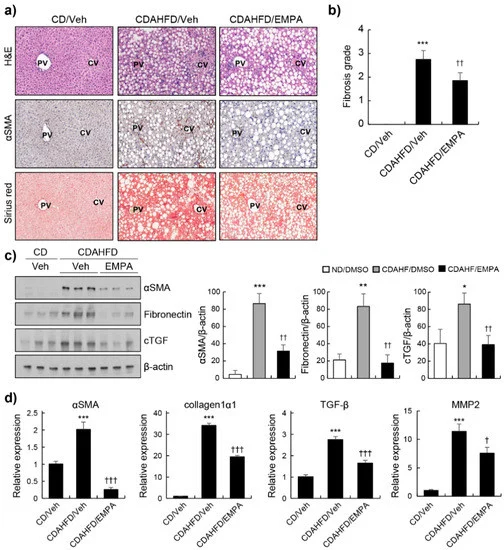
[논문/Biomedicines]Empagliflozin reduces the progression of hepatic fibrosis in a 2 mouse model and inhibits the activation of hepatic stellate cells 3 via the Hippo signalling pathway
작성자
관리자작성일자
2022-05-24 09:00조회수
98KIURI 허유정 신진연구인력 논문
Biomedicines. 2022 Apr 29; doi: 10.3390/biomedicines10051032
Empagliflozin reduces the progression of hepatic fibrosis in a 2 mouse model and inhibits the activation of hepatic stellate cells 3 via the Hippo signalling pathway
Hepatic fibrosis is the excessive production and deposition of the extracellular matrix, resulting in the activation of the fibrogenic phenotype of hepatic stellate cells (HSCs). The Hippo/Yes-associated protein (YAP) signalling pathway is a highly conserved kinase cascade that is critical in regulating cell proliferation, differentiation, and survival, and controls stellate cell activation. Empagliflozin, a sodium-glucose cotransporter type-2 inhibitor, is an antidiabetic drug that may prevent fibrotic progression by reducing hepatic steatosis and inflammation. However, little is known about its mechanism of action in liver fibrosis. In this study, we used male C57 BL/6 J mice fed a choline-deficient, l-amino acid-defined, high-fat diet (CDAHFD) as a model for hepatic fibrosis. For 5 weeks, the mice received either a vehicle or empagliflozin based on their assigned group. Empagliflozin attenuated CDAHFD-induced liver fibrosis. Thereafter, we identified the Hippo pathway, along with its effector, YAP, as a key pathway in the mouse liver. Hippo signalling is inactivated in the fibrotic liver, but empagliflozin treatment activated Hippo signalling and decreased YAP activity. In addition, empagliflozin downregulated the expression of pro-fibrogenic genes and activated Hippo signalling in HSCs. We identified a mechanism by which empagliflozin ameliorates liver fibrosis.
Keywords: hepatic fibrosis; Hippo signalling pathway; hepatic stellate cells; empagliflozin
